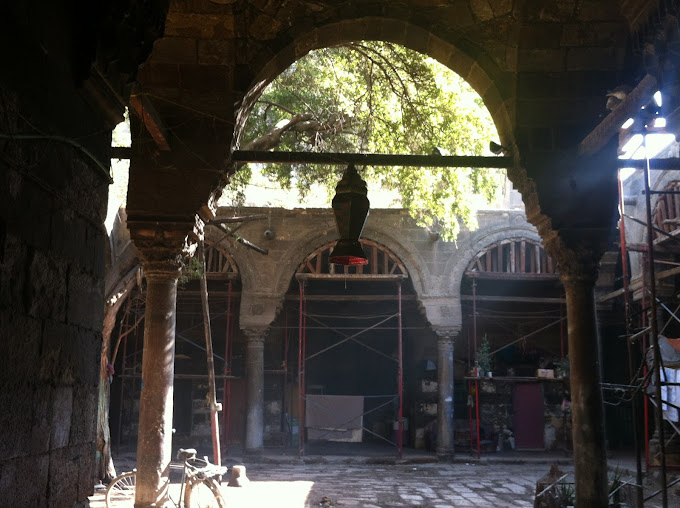Sacred Spaces: Exploring 5 of Egypt’s Hidden Tekkiyas
architecture arts & culture arts and culture Egyptian history Mamluk Architecture Tekkiya
Safy Allam
Egypt, a land rich in history and heritage, is known for its stunning monuments, pyramids, and temples. Yet, hidden within its urban mazes lie little-known treasures: the Tekkiyas. A Tekkiya is a spiritual retreat or lodge associated with Sufi orders, where individuals gather for prayer, meditation, and spiritual growth. These sacred spaces, often designed with beautiful architecture, offer a glimpse into Egypt’s mystical traditions and deeply rooted Islamic culture.
Egypt’s Tekkiyas are live reminders of its rich spiritual history, from the tranquil reflection of Sufi activities to the mesmerising whirls of the Mawlawi dervishes. Let’s examine five of these outstanding locations in more detail, each with a distinct tale to tell.
Tekkiya and Dome of Ibrahim al-Kalshani

Image via youm7
One of Cairo’s first Sufi religious complexes, the Tekkiya and Dome of Ibrahim al-Kalshani was constructed between 1519 and 1524 and dedicated to the Sufi saint Ibrahim al-Kalshani, who died in 1534. The complex is credited with introducing the word “Tekkiya” following the Ottoman takeover. Known for its unique dome and spacious courtyard, the Tekkiya features a mosque, residential rooms, and commercial spaces for worshippers.
As a vital component of Cairo’s rich spiritual legacy, the complex is currently undergoing restoration efforts to preserve its cultural value due to its distinctive design and historical significance.
Al-Tekkiya Al-Mawlawiya

Image via cairo360
Located in Hilmiyya El-Gedida, Al-Tekkiya Al-Mawlawiya is a key monument in Cairo that preserves the legacy of the Mawlawi Sufi order, famously linked to Jalal ad-Din Rumi. This historical complex, which includes the Sama Khana (whirling dervish hall), tombs of prominent Sufi figures, and a rich collection of Sufi literature, offers a rare glimpse into Egypt’s mystical heritage.
It also played a role in the first Arab music conference in 1982 and remains a centre for exploring Sufi traditions and teachings.
Tekkiya of Taqi al-Din al-Bustami

Image via elwatannews
Built in the 16th century, Tekkiya of Taqi al-Din al-Bustami is a significant Sufi retreat located in Bab El Wazir at Cairo. Named after the renowned mystic and scholar Taqi al-Din al-Bustami, it blends Mamluk and Ottoman architectural styles with intricate carvings and peaceful courtyards. Originally constructed as a residence for a Sufi sheikh, it later became a gathering place for Sufis from Central Asia during the Ottoman period.
After being closed for a while, it reopened in 2018 as part of the Bab al-Wazir archaeological area, transforming it into a cultural and social hub for the local community. Its design reflects the spiritual depth of Sufism while offering a serene space for reflection and learning.
Tekkiya of Muhammad Bey Abu al-Dahab

Image via mahfouzmuseum
The Tekkiya of Muhammad Bey Abu al-Dahab, built in the 18th century, is a striking example of Ottoman architecture in Cairo. Founded by Muhammad Bey, a prominent military leader, it was initially established as a religious institution for Sufi worship and meditation. Located near Al-Azhar Mosque, the Tekkiya is known for its grand design, with intricate details and spacious courtyards that offer a peaceful atmosphere for reflection.
The complex includes both a mosque and a Sufi residence, and it remains an important historical and cultural landmark, reflecting the spiritual and political influences of Egypt’s Ottoman era.
The Suleymaniye Tekkiya

Image via google
Nestled in Al Darb El Ahmar in Cairo, the Suleymaniye Tekkiya, constructed in 1543 by Sultan Suleiman the Magnificent, stands as a remarkable symbol of Ottoman architecture and spiritual life. Built as a centre for the Qadiri Sufi order, it showcases the grandeur of Ottoman design with its intricate tile decorations, expansive prayer halls, and serene courtyard. The Tekkiya also contains the tombs of notable Sufi saints.
Its unique architectural features include the central courtyard surrounded by rooms, a prominent mihrab, and upper floors covered with shallow domes, marking it as the first Ottoman building in Egypt to incorporate this distinctive style. The Suleymaniye Tekkiya continues to be both a spiritual sanctuary and an enduring testament to Egypt’s Ottoman legacy.
recommended
 Cafés
Cafés
Bite Into the Croffle Craze: The Best 5 Spots to Try Croffles in Cairo
cafes cairo +2 City Life
City Life



